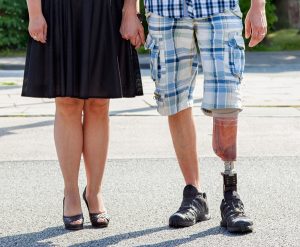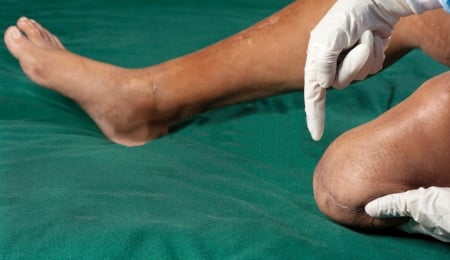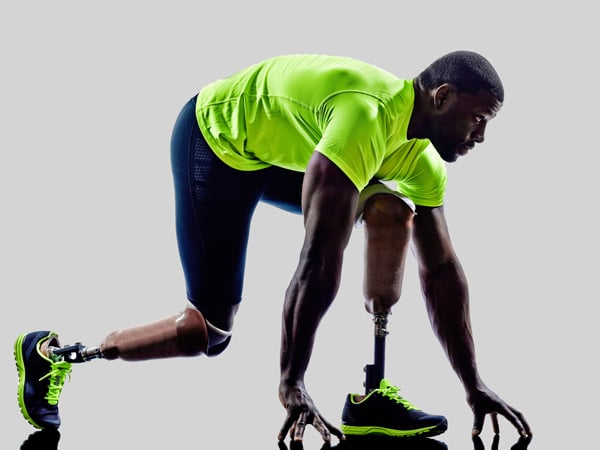When the weather changes, so does your body. Warm, humid air may turn your straight hair curly; dry winter air may send you running for the lotion three times a day. But aside from using sunscreen, there are a lot of other things to consider when it comes to warm weather skin care for amputees. Let’s take a look at two things to keep in mind as spring arrives this year!
Preventing Infection
You’re going to sweat in the spring and summer -- that much is inevitable! But if your residual limb is sweating in its socket all day, you may end up with a bacterial infection. Nobody wants that!
At least once a day, wash your prosthetic socket and your residual limb with antibacterial soap in order to prevent infection from occurring. It’s also wise to wash your prosthetic socks and liners and least once daily, making sure they are totally dry before you wear them again.
Preventing the Breakdown of Your Skin
Being outside a lot when the weather is warm is great for you! But the more active you are with your prosthetic device, the more risk you have of your skin breaking down around it.
To keep your skin healthy, be sure your prosthesis fits perfectly and that you are maintaining a steady weight. Drink lots of water and eat healthy foods whenever possible so that bloating is minimal. This will help your skin stay in great shape through the end of the summer!
Contact BioTech with Questions about Skin Care for Amputees!
If you have any questions or concerns about taking care of your skin this spring and summer, let us know! We are ready and willing to help you in any way we can. Contact us today!
If you have suffered from limb loss, then we think it is important to understand that you are not alone! Although everyone has different experiences and specific situations that led to amputation, there is an amazing community that will be there to help you along the way.
BioTech Limb and Brace has put together some helpful tips for those dealing with limb loss to help you adjust. Check them out below.
The Feeling You Get Immediately After Surgery WILL Pass
One of the most important things to remember is that every amputee goes through the common stages of dealing with their situation. Many report waking up after the operation with a variety of feelings. Rest assured that the feelings of uncertainty, fear, and being overwhelmed will pass.
Turn “What If” Into Optimistic Thinking
Thanks to modern technology, living life as someone dealing with the loss of a limb has an absolutely amazing outlook. It is important that you try to combat negative and “what if” thinking with optimistic, positive outlooks. There are hundreds - no thousands - of incredible stories of amputees that are accomplishing their dreams - the same exact dreams they had before becoming an amputee. You can do it and reminding yourself that on a regular basis is important when you have experienced limb loss.
Seek Out Other Amputees
One of the best ways to see for yourself all of the incredible possibilities ahead of you is to engage with other amputees. Get tuned into your new community - there are amazing individuals who have been exactly where you are and would love to welcome you as part of the family.
When you’re dealing with limb loss, you are never alone. The community is absolutely incredible! Check out the Amputee Coalition website. Follow BioTech on Facebook and other social media platforms. Plug into community and regional events.
Additional Helpful Information
For additional information on adjusting to your new life, check out the links below:
- Post-Op Amputation Self-Care Tips by BioTech Limb and Brace
- Information for Lower Limb Amputees and Their Families by Ottobock
- Traveling with a Prosthesis by BioTech Limb and Brace
- Tips for Taking Care of Your Limb by Amputee Coalition
 Phantom pain is pain that can be felt by those who have lost a limb. The pain feels like it is coming from that limb that is no longer there. Phantom pain is most often experienced in amputee patients, not those already born without limbs.
Phantom pain is pain that can be felt by those who have lost a limb. The pain feels like it is coming from that limb that is no longer there. Phantom pain is most often experienced in amputee patients, not those already born without limbs.
Not long ago, doctors theorized that post-amputation phantom pain was psychological. However, it has now been identified as a physical problem. Experts have observed neural activity in the brain during these phantom pain episodes originating from nerves in the spinal cord and other limbs.
For many patients, phantom pain is post-surgery phenomenon that improves with time. However, for others the pain does not go away. To manage that pain, one should always seek professional advice from their doctor to receive proper treatment, in the form of medication and/or therapy.
Here’s more on phantom pain and how to handle it.
Symptoms and Causes of Phantom Pain
The symptoms of phantom pain are exactly that: pain. Throbbing, stinging, burning, shooting sensations from limbs that are no longer there constitute phantom pain.
Researchers are still unclear as to the cause of phantom pain, but with the help of diagnostic imaging scans it has become apparent that the brain can receive mixed signals from the nerves. The nerve ends in the area of the missing limb may send signals to the brain which trigger pain even if it is mild discomfort or just a touch. Sometimes, the brain may even reroute the nerve signals.
For example, sensory nerves in other parts of the body like the face may trigger phantom pain from a missing right leg. So that when you touch that part of your face, your brain registers that sensation as leg pain. It truly is a fascinating phenomenon.
How to Fight Phantom Pain
Often, amputees feel the most pain in the remaining body part or the stump. This pain can be extremely challenging to live with. However, it does usually fade with time, and it can be both prevented and treated. Phantom pain and stump pain tend to occur in the lower limbs (toes, feet, legs), and they are usually sparked by changes in the weather, pressure from other objects on the remaining body parts, stress, and poorly-fitting prosthetics.
Therapy techniques like massages, electrical stimulation through EMGs (electromyography), stump socks and proper skin care, as well as prosthetic fittings, can all help. Treatment focuses on how changing the way the sensations are represented in the brain. Seeing a physical therapist is often advantageous as well. Exercises, manipulation, and training can be good for your limbs in general and especially to deal with the pain.
With the right medication and physical therapy, this pain can be treated. To help prevent stump and phantom pain in the first place, getting a custom-fit prosthetic is beneficial. The right professionals can make sure your prosthetic fits well, provides you with comfort and convenience, and adds to your everyday functionality while also making sure that your body is not experiencing pressure and discomfort from the limb.
Contact BioTech Limb and Brace Today
BioTech customizes prosthetics to ensure your functionality and comfort. Our goal is to create limbs that fit you perfectly and provide you with both comfort and convenience. Contact BioTech today and recognize your possibilities!
 Amputation surgery can be an overwhelming experience. The time you spend recovering in the hospital can seem like a blur in your memory as you work to process all of the information and cope with your new life. Understandably so, it can be easy to forget the post-op self-care tips you received at discharge.
Amputation surgery can be an overwhelming experience. The time you spend recovering in the hospital can seem like a blur in your memory as you work to process all of the information and cope with your new life. Understandably so, it can be easy to forget the post-op self-care tips you received at discharge.
At BioTech we understand the importance of proper self-care while healing from your amputation surgery. A proper healing process is key to the effective use of a future prosthesis.
Below are some ways to make sure your healing process goes as smoothly as possible after your amputation surgery.
#1: Follow Doctor’s Orders
Your doctor knows exactly what you need to do for the best outcome of your surgery. Don’t ignore his or her instructions. If you have a question about anything the doctor has told you to do, make sure you express your concerns and get their advice. Never stop any of your treatment without consulting with your doctor first.
Make sure you are positioning your body based on your doctor’s instructions. Laying on your stomach for 20 minutes, three to four times each day, will help to stretch out your hip muscle. Always sit with your stump straight and level and avoid turning it in or out from your body. If you will be lying down for a long period of time, keep your stump elevated to avoid swelling.
If you doctor prescribes you medicine, take it for as long as prescribed. If your doctor orders physical therapy, keep going until your doctor tells you it’s time to stop. If you physician tells you to keep your stump wrapped, wrap it daily and tighten it when it gets loose. Only take it off to shower.
Realizing that your doctor knows best will go a long way towards your healing; therefore, make sure you follow his or her instructions directly for best results now and in the future.
#2: Choose a Healthy Lifestyle
Some of the things that will greatly benefit your healing are the same things that keep anyone healthy. Proper nutrition and exercise will expedite your healing process and keep you in better shape.
Start by switching to a high protein diet. Aim for a protein intake of 1.5-2 grams per kilogram of body weight daily. Limit your sugar as well for the best results. Diabetic amputees should especially control their glucose levels for proper healing.
Another great way to help with healing while improving your overall health is to stop smoking. Ideally, smoking should have ceased four to eight weeks before surgery, but it’s never too late to quit if you did not kick the habit before your operation. Ceasing smoking immediately can greatly reduce post-op complications!
#3: Strengthen Your Body
The stronger your body, the quicker you will recover and the greater likelihood you will be able to successfully adapt to a new prosthesis. You need to build your strength and your endurance.
Doing a good cardio workout, such as swimming, will build up your endurance and improve your general health. Also, because you will have a new center of gravity, balance exercises will be of great benefit. Before engaging in any exercise, consult with your physician first to make sure you are ready.
If you have a lower limb amputation, use weights or resistance bands to work your upper body. Using a walker or wheelchair will require more use of your arms than you are probably used to; therefore, strengthening your arms goes a long way at helping you adapt to your post-op lifestyle.
Working your core helps support your whole body. You can work your core while seated or even in bed. Your physical therapist can give you the best exercises for strengthening your core during your healing process.
Also remember that your unaffected limb will likely be carrying more of the workload now; therefore, be sure to condition it properly. At the same time, you don’t want to ignore the stump. A strong stump is the foundation of proper prosthesis use! Even when it’s hard and even when you would rather do anything but exercise, follow the instructions given to you by your physical therapist. Later, you will be glad that you took their advice.
Contact BioTech Limb and Brace Today for Your Custom Prosthetic Needs
BioTech offers custom prosthetics that will help give you amazing function, helping you to recognize your possibilities!
Our goal is to create a limb that fits you perfectly with the utmost level of comfort and convenience. Contact BioTech today to learn more about how we can help.

